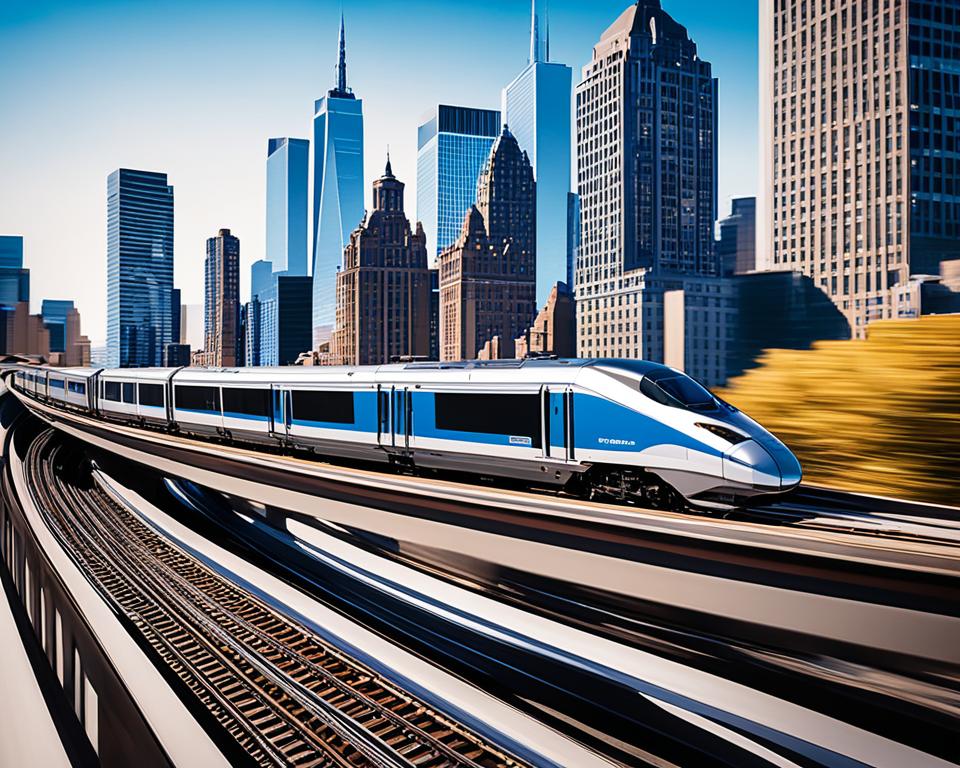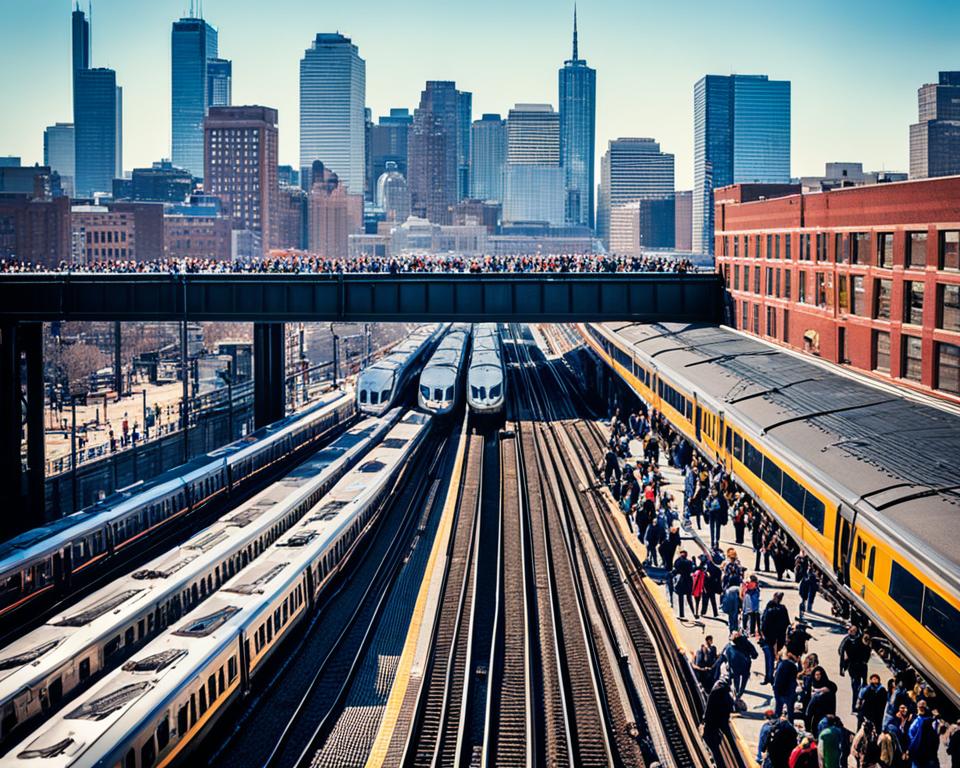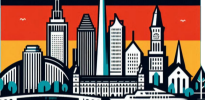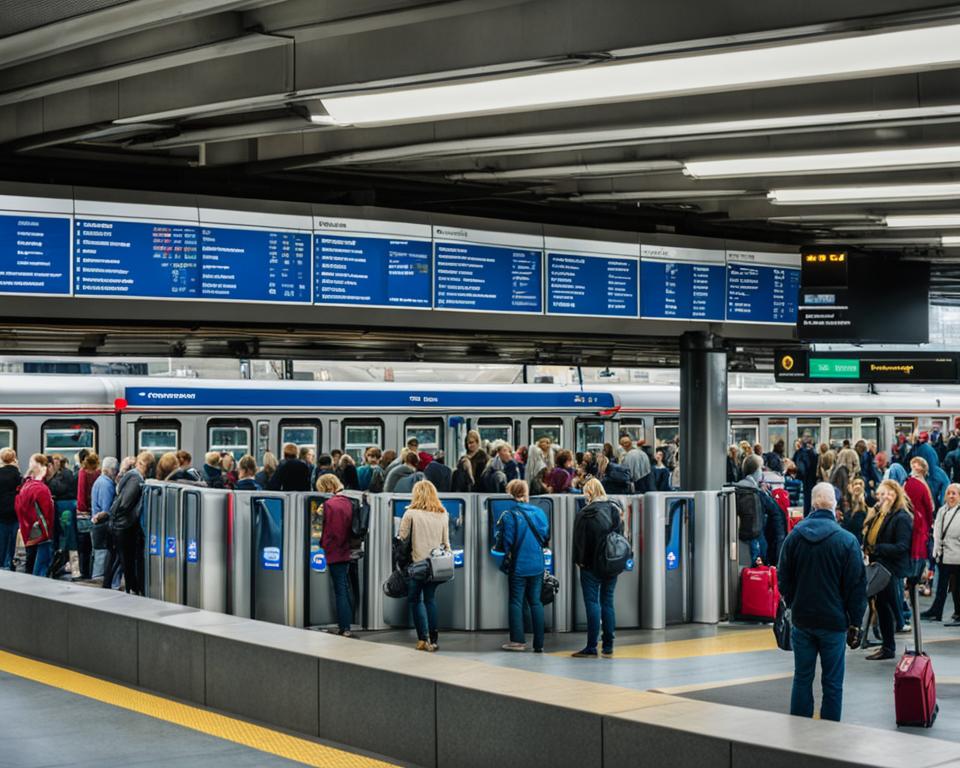“The greatness of a community is most accurately measured by the compassionate actions of its members.” – Coretta Scott King. This quote from Coretta Scott King highlights how key public transportation is for a strong community. In the U.S., our public transit systems link people, boost the economy, and help with sustainable city growth.
Our public transportation is vital, from commuter rails to subway networks. These systems move people every day. We’ll look at the different ways people get around the country. We’ll see how these systems keep our communities together and the new solutions for a greener future.
Key Takeaways
- Public transportation is a vital part of moving people and building communities in the U.S.
- The U.S. has many public transit options, like commuter rail, subway, light rail, and bus rapid transit.
- Investing in public transportation is important for making cities more accessible and sustainable.
- Good public transit connects people, creates jobs, and helps the environment.
- Using new ideas and a full approach to public transportation helps meet the changing needs of communities.
Introduction to Public Transportation in the USA
Public transportation is key for many Americans. It helps commuters, students, the elderly, and those without cars get around. We’ll explore why public transit matters and the different ways people travel, like commuter rail, subway, light rail, and bus rapid transit.
The Importance of Public Transit
Public transportation is vital for cities and suburbs. It links people to jobs, schools, and community spots. Using public transit lessens traffic, cuts down on pollution, and offers a greener way to travel.
Modes of Public Transportation
- Commuter Rail: Commuter rail helps people travel from suburbs to cities for work or school.
- Subway Systems: Big cities like New York, Chicago, and Washington, D.C., have subway networks. They’re fast and carry lots of people.
- Light Rail Transit: Light rail is a type of rail that runs on streets. It’s cheaper and flexible for moving people around cities.
- Bus Rapid Transit: BRT uses special buses with their own lanes. It makes riding faster, more reliable, and comfy.
These public transport options are key to moving people around cities. They help communities grow and support the economy in the U.S.

Commuter Rail: A Vital Artery
Commuter rail systems are key to public transport in many U.S. cities. They link suburbs to city centers, helping millions commute daily. This makes them a reliable way to travel.
These trains are crucial for better transport access and supporting the transit network. They connect homes to work, easing traffic, cutting down on pollution, and making life better for city and suburb folks.
Commuter trains run on their tracks or share with other trains. They have regular stops at stations, making them a quick way to get around. Trains have comfy seats, WiFi, and sometimes food and drinks, making trips more enjoyable.
Commuter rail is great for reaching far-out suburbs and exurbs. It makes public transport wider and boosts mobility across regions. It’s a solid choice over driving, cutting down on traffic, improving air quality, and supporting green city growth.
| Commuter Rail System | Ridership (2019) | Coverage Area |
|---|---|---|
| New York City’s MTA Long Island Rail Road | 91.1 million | Long Island and New York City |
| Chicago’s Metra | 81.4 million | Chicagoland region |
| Boston’s MBTA Commuter Rail | 39.4 million | Greater Boston area |
| San Francisco’s Caltrain | 19.2 million | San Francisco Peninsula |
As the U.S. grows and cities spread, commuter rail’s importance will grow too. Investing in these systems helps connect regions, cuts traffic, and supports green city growth.

The Backbone: Subway Systems
Subway systems are key to public transport in many big cities. They offer high-capacity, frequent service, and smooth connections. This makes them vital for city dwellers. We’ll look at how these systems are making travel easier and more convenient for everyone.
Major Subway Networks
The New York City Subway, the busy Chicago ‘L’, and the growing Los Angeles Metro are just a few examples. These vast networks are crucial for public transport, helping millions move daily. They connect people with ease, offering frequent rides and wide coverage.
Accessibility and Convenience
Subway systems are getting better at serving everyone. With new upgrades, they now have things like accessible platforms and real-time info. These changes make sure public transport meets the needs of all city folks.
Looking into subway systems, we see they’re key to city travel. They offer a dependable way for millions of Americans to get around.
“Subway systems are the lifeblood of public transportation, providing a reliable and efficient means of travel for urban residents.”
Public Transportation: Overview of System and Trains in usa
The public transportation system in the United States is complex and connects people across the country. Trains are key in this system, linking cities and rural areas. They work with other modes like commuter rail and subway systems.
Amtrak is at the center of this network, offering long-distance and regional routes. It lets travelers see the USA’s diverse landscapes and cities. These trains make traveling easy and help our transit system be more sustainable.
Many cities have their own commuter rail systems for people going to work. These commuter trains connect suburbs and towns to city centers. They help reduce traffic and make commuting easier.
In cities like New York, Chicago, and Washington, D.C., subway systems offer quick and easy travel. These networks, along with light rail and bus rapid transit, make up a complete public transport system. They meet the needs of everyone living in the city.
By combining trains with other public transport, we aim for a better, fair, and efficient transport future. Investing in transit infrastructure and connecting different transport modes is important. It keeps our communities connected and accessible.
Light Rail Transit: Urban Mobility
Cities in the United States face big challenges with traffic and need for green transport. Light rail transit (LRT) is a flexible and affordable way to improve city travel. It’s efficient, easy to use, and good for the planet. This makes it key for public transport in the country.
Flexibility and Cost-Effectiveness
Light rail is more adaptable than heavy rail, fitting well into different city settings. It can use existing paths or share tracks with other transport. This makes it easy to add to a city without big changes or costs.
Also, building and running light rail is cheaper than heavy rail. Cities can invest in it without spending a lot. This helps make cities better places to live, with easy travel options and less pollution.
“Light rail transit systems have transformed the way we think about urban mobility, offering a flexible and cost-effective solution that can be tailored to the unique needs of each community.”
As cities focus on being green and improving public transport, light rail is a top choice. It offers efficient, easy, and green ways to move around. Light rail is set to be a big part of the future of transport in American cities.
Bus Rapid Transit: Efficient and Affordable
In the ever-changing world of city travel, bus rapid transit (BRT) is changing the game. It blends the speed of rail with the flexibility of buses. This makes it a top choice for cities in the U.S.
BRT offers a smooth and accessible transportation experience. With special lanes and priority signals, it cuts down travel time. It also makes getting around easier for everyone. Plus, it’s affordable, making it a great option for many cities.
BRT can be customized for each city’s needs. It can include features like touchless fares and real-time updates. These add to the great BRT experience.
| Key Benefits of Bus Rapid Transit | Comparison |
|---|---|
|
|
Cities are looking for ways to make travel easier and greener. Bus rapid transit is a key solution. It’s efficient, affordable, and improves the travel experience.
“Bus Rapid Transit systems are revolutionizing the way people move through cities, offering a cost-effective and efficient alternative to traditional public transportation.”
Urban Mobility Solutions for the Future
Cities are growing and changing fast, making us need new and green ways to move around. We’re seeing new ideas like combining different transport types, like buses and bikes, to make travel better and greener.
Multimodal Integration
Multimodal integration is changing how we move in cities. It links different transport options, like buses, ride-sharing, biking, and walking, into one system. This makes getting around easier and less dependent on cars, helping our planet too.
Sustainable Urban Development
Thinking about the future, we know we need to make cities better for everyone. Public transport is key in this plan. It’s a green way to move people that cuts down on pollution and traffic. Adding biking and other green ways to travel makes our cities even better for the planet.
| Multimodal Integration | Sustainable Urban Development |
|---|---|
|
|
By using these new ways to move, we can make cities better for everyone. They’ll be easier to get around in, work better, and be kinder to our planet. This will make life better for all of us.
“The future of urban mobility lies in the seamless integration of public transportation with sustainable modes, creating a comprehensive and user-friendly system that caters to the diverse needs of commuters.”
Investing in Transit Infrastructure
Governments in the United States are putting a lot of money into transit infrastructure. This is key for making public transport better, more reliable, and good for the environment.
They’re updating old subway and commuter rail systems and building new light rail and bus rapid transit lines. These projects make getting around easier and help cities grow in a green way. By doing this, we can offer more ways to travel that are both fast and kind to the planet.
New York City is a great example with its Second Avenue Subway and 7 line extension. Los Angeles, Denver, and Seattle are also adding new light rail to link city and suburb.
“These infrastructure investments are not just about building new transit lines; they’re about transforming the way people move around our cities and communities.”
Transit agencies are also working on tech upgrades. They’re improving fare systems, giving better real-time info, and combining different transport options. These changes make public transport better for everyone, making it a top choice for getting around.
Looking ahead, we need to keep investing in transit infrastructure. This will help make our communities better, more sustainable, and fair for everyone. By focusing on public transport, we can make sure everyone has easy access to where they need to go. This is good for people and the planet.
Conclusion: Embracing Accessible Transportation
In the heart of our nation, public transportation is key. It connects communities and helps people move easily through their daily lives. Looking ahead, making transportation accessible and connected is crucial for our cities and their people.
We need to invest in making cities better and in transportation that meets everyone’s needs. This means looking at everything from fast trains to new light rail systems. These changes will make moving around easier and help our cities be greener and more livable.
We must keep working to make getting around easier for everyone. By working together, we can make public transport a key part of our cities. This will bring people closer, help our economy grow, and make a better future for all.

